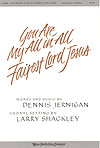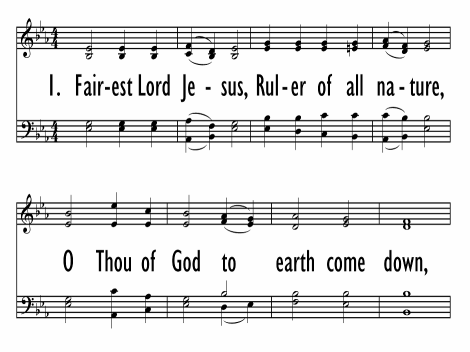- |
User Links
Fairest Lord Jesus

Fairest Lord Jesus, Ruler of all nature
Author: Friedrich von Spee; Author: AnonymousTune: CRUSADERS' HYMN (111271)
Songs of Response
Published in 591 hymnals
Printable scores: PDFPlayable presentation: Lyrics only, lyrics + musicAudio files: MIDI, Recording
Representative Text
1 Fairest Lord Jesus,
ruler of all nature,
O thou of God and man the Son,
Thee will I cherish,
Thee will I honor,
thou, my soul's glory, joy, and crown.
2 Fair are the meadows,
fairer still the woodlands,
robed in the blooming garb of spring:
Jesus is fairer,
Jesus is purer
who makes the woeful heart to sing.
3 Fair is the sunshine,
fairer still the moonlight,
and all the twinkling starry host:
Jesus shines brighter,
Jesus shines purer
than all the angels heaven can boast.
4 Beautiful Savior!
Lord of all the nations!
Son of God and Son of Man!
Glory and honor,
praise, adoration,
now and forevermore be thine.
United Methodist Hymnal, 1989
Author: Friedrich von Spee
Spee, Friedrich von, son of Peter Spee (of the family of Spee, of Langenfeld), judge at Kaisers worth, was born at Kaisersworth, Feb. 25, 1591. He was educated in the Jesuit gymnasium at Cologne, entered the order of the Jesuits there on Sept. 22, 1610, and was ordained priest about 1621. From 1613 to 1624 he was one of the tutors in the Jesuit college at Cologne, and was then sent to Paderborn to assist in the Counter Reformation. In 1627 he was summoned by the Bishop of Würzburg to act as confessor to persons accused of witchcraft, and, within two years, had to accompany to the stake some 200 persons, of all ranks and ages, in whose innocence he himself firmly believed (His Cautio criminalis, sen de processibus contra sagas lib, Rinteln,… Go to person page >Author: Anonymous
In some hymnals, the editors noted that a hymn's author is unknown to them, and so this artificial "person" entry is used to reflect that fact. Obviously, the hymns attributed to "Author Unknown" "Unknown" or "Anonymous" could have been written by many people over a span of many centuries. Go to person page >Text Information
Related Texts
| First Line: | Fairest Lord Jesus, Ruler of all nature |
| Title: | Fairest Lord Jesus |
| German Title: | Schönster Herr Jesu |
| Author: | Anonymous |
| Author: | Friedrich von Spee |
| Meter: | 5.6.8.5.5.8 |
| Source: | German: 17th Century; Münster Gesangbuch (1677) |
| Place of Origin: | Germany |
| Language: | English |
| Notes: | Spanish translation: See "Cristo hermoso" |
| Copyright: | Public Domain |
| Liturgical Use: | Songs of Response |
- Year A, Christmas season, Christmas Eve
- Year B, Ordinary Time, Proper 16 (21)
- Year B, Ordinary Time, Proper 17 (22)
This is recommended for Year B, Ordinary Time, Proper 17 (22) by 2 hymnal lectionary indexes including Glory to God: the Presbyterian Hymnal #630. - Year C, Christmas Season, Second Sunday after Christmas Day
- Year C, Easter season, Ascension of the Lord
- Year C, Ordinary Time, Proper 21 (26)
Notes
Access an additional article on the Canterbury Dictionary of Hymnology:
Tune
CRUSADERS' HYMN (111271)ST. ELIZABETH appears to be an eighteenth-century tune from the Glaz area of Silesia. It has always been associated with this text. No factual data exists for the legend that this text and tune date back to the twelfth-century crusades, although those apocryphal stories explain one of the names by w…
For Leaders
Text:
The original, anonymous German text of this hymn first appeared in a 1662 manuscript in Münster, Germany. It was known in Germany, but its wider popularity came when A. H. Hoffman von Fallersleben and E. F. Richter published it in Schlesische Volkslieder, a collection of folk songs from Silesia, in 1842. There are two translations in common use. One is by Joseph Seiss and is titled “Beautiful Savior.” The other, which is more common, is anonymous and first appeared in Richard Storrs Willis's Church Chorals and Choir Studies in 1850. The text typically appears with four stanzas, which are all on the theme of the beauty of creation and the greater beauty of Christ, the Savior.
Tune:
The tune that is best known with this text is usually called CRUSADER'S HYMN. It is also sometimes named SCHÖNSTER HERR JESU, after the first line of the German text. After it was used as a crusader's march in Franz Liszt's 1862 oratorio, The Legend of St. Elizabeth, the tune was also named ST. ELIZABETH. Though it is not the original tune for this text, SCHÖNSTER HERR JESU has been associated with “Fairest Lord Jesus” since both appeared in Fallersleben's and Richter's Schlesische Volkslieder in 1842.
This tune has the flexibility to be sung with a gentle mood or a powerful one, depending on the accompanying instruments and their volume. It is a flowing tune, and congregations may lose their rhythmic unison between the third and fourth lines unless the leader indicates clearly where to take a breath.
When/Why/How:
This hymn may be used as an opening hymn of praise or as a hymn of response. It may be sung at any time of year, and it is suitable for use at Christmas, especially in medley with carols, such as in the handbell setting combining “O Come Let Us Adore Him” with “Fairest Lord Jesus.” The frequent allusions to the beauty of nature make it suitable for use as a simple “Spring Carol,” in a choral setting for SAB choir accompanied only by a few handbells. The tune blends well with some contemporary worship songs, making it suitable for a blended worship service, such as in the medley “You Are My All in All/Fairest Lord Jesus.”
Tiffany Shomsky, Hymnary.org
Timeline
Arrangements
Media
Small Church Music #2951
- PDF Score (PDF)
The United Methodist Hymnal #189
- MIDI file from Baptist Hymnal 1991 #176
- Audio recording from Baptist Hymnal 1991 #176
- MIDI file from Baptist Hymnal 1991 #176
- MIDI file from The Cyber Hymnal #1423
- Audio recording from Glory to God: the Presbyterian Hymnal #630
- Audio recording from Small Church Music #68
- Audio recording from Small Church Music #68
- Audio recording from Small Church Music #2951
- MIDI file from Songs of the Kingdom: prepared for the use of young people's societies and adapter for prayer meetings, Sunday schools and the home #21
- Audio recording from Trinity Hymnal (Rev. ed.) #170
- Audio recording from Trinity Hymnal (Rev. ed.) #171
- MIDI file from Timeless Truths #1089
- MIDI file from The United Methodist Hymnal #189
- Audio recording from The United Methodist Hymnal #189
- MIDI file from Worship and Rejoice #123
- MIDI file from Worship in Song: A Friends Hymnal #120


 My Starred Hymns
My Starred Hymns





